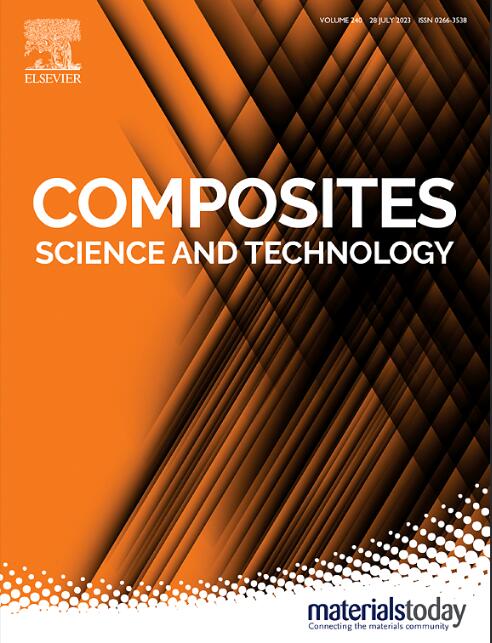高应变率下单向CF/PEEK复合材料层合板热-力学动态响应特性研究
IF 8.3
1区 材料科学
Q1 MATERIALS SCIENCE, COMPOSITES
引用次数: 0
摘要
本研究采用理论、数值和实验相结合的方法,系统地研究了CF/PEEK复合材料层合板在纵向和厚度方向上的高速冲击行为。在热力学第二定律的框架下,严格建立了冲击过程中温升的必然性和刚度退化的不可逆性,为研究半结晶热塑性复合材料的热-力学响应奠定了基础。在碰撞过程中产生热量的机制和潜在原因得到推导和验证,为能量耗散,损伤演化以及热与机械现象之间的相互作用提供了有价值的见解。基于渐进式损伤生热理论的有限元分析(FEA),准确捕获了单向CF/PEEK复合材料层合板试样内部的温升和应力分布,与实验数据具有较强的相关性。分析表明,纵向冲击主要导致界面破坏、纤维断裂和剪切开裂,而横向和厚度方向的冲击主要导致纤维间破坏(IFF),裂纹以55°角扩展。这是由于单向复合材料的各向异性影响了剪切应力的分布,控制了裂纹的扩展方向。在两种冲击情景下,均观察到广泛的塑性变形和脆性断裂,进一步证实了机械能转化为热能。这些发现为复合材料在极端机械和热载荷条件下的结构设计和优化提供了有价值的见解。本文章由计算机程序翻译,如有差异,请以英文原文为准。

A study on the thermo-mechanical dynamic response characteristics of unidirectional CF/PEEK composite laminates under high strain rates
This study systematically investigates the high-velocity impact behavior of CF/PEEK composite laminates along both the longitudinal and thickness directions using a combined theoretical, numerical, and experimental approach. Within the framework of the second law of thermodynamics, the inevitability of temperature rise and the irreversibility of stiffness degradation during impact processes were rigorously established, laying a fundamental foundation for investigating the thermo-mechanical response of semi-crystalline thermoplastic composites. The mechanisms and underlying causes of heat generation during impact were derived and validated, offering valuable insights into energy dissipation, damage evolution, and the interaction between thermal and mechanical phenomena. The finite element analysis (FEA), based on the proposed progressive damage-based heat generation theory, accurately captured both the temperature rise and stress distribution within the unidirectional CF/PEEK composite laminate specimens, demonstrating a strong correlation with the experimental data. The analysis revealed that impacts along the longitudinal direction primarily induce interfacial failure, fiber breakage, and shear cracking, whereas impacts along the transverse and thickness directions lead to inter-fiber failure (IFF), with cracks propagating at a 55° angle. This behavior is attributed to the anisotropic nature of unidirectional composites, which influences the shear stress distribution and governs the crack propagation direction. In both impact scenarios, extensive plastic deformation and brittle fracture were observed, further confirming the conversion of mechanical energy into thermal energy. These findings provide valuable insights for the structural design and optimization of composite materials subjected to extreme mechanical and thermal loading conditions.
求助全文
通过发布文献求助,成功后即可免费获取论文全文。
去求助
来源期刊

Composites Science and Technology
工程技术-材料科学:复合
CiteScore
16.20
自引率
9.90%
发文量
611
审稿时长
33 days
期刊介绍:
Composites Science and Technology publishes refereed original articles on the fundamental and applied science of engineering composites. The focus of this journal is on polymeric matrix composites with reinforcements/fillers ranging from nano- to macro-scale. CSTE encourages manuscripts reporting unique, innovative contributions to the physics, chemistry, materials science and applied mechanics aspects of advanced composites.
Besides traditional fiber reinforced composites, novel composites with significant potential for engineering applications are encouraged.
 求助内容:
求助内容: 应助结果提醒方式:
应助结果提醒方式:


